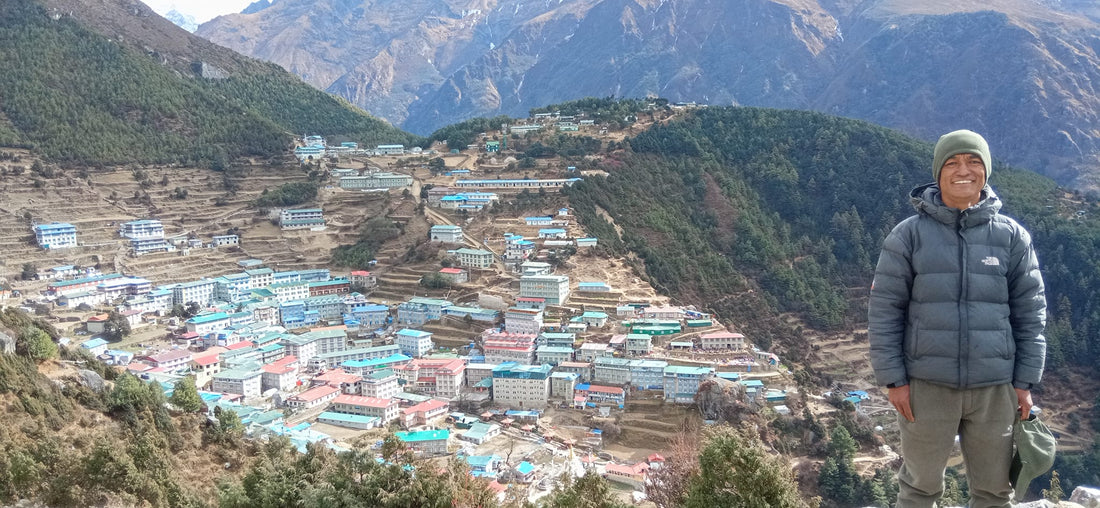
Jiri to Everest Base Camp
Tanya BakerShare
Jiri to Everest Base Camp Trek: A Traditional Himalayan Journey
The Jiri to Everest Base Camp (EBC) trek is a classic route following the footsteps of early Everest pioneers. This traditional trail offers a rich cultural experience and stunning Himalayan scenery, making it an incredible alternative to the popular Lukla route.
Overview
- Start/End Point: Kathmandu, Nepal
- Max Altitude: Everest Base Camp (5,364m) and Kala Patthar (5,545m)
- Duration: Approximately 22–26 days. This trek is fully customizable for you so please use this as a guide only
- Difficulty: Challenging
- Best Seasons: Spring (March–May) and Autumn (September–November)
- Permits Required: Sagarmatha National Park Permit & the Khumbu Pasang Lhamu Rural Municipality Entry Permit
Why Choose the Jiri Route?
- Follows the original route used by Sir Edmund Hillary and Tenzing Norgay in 1953.
- Gradual acclimatization with lower altitude gains.
- Less crowded compared to the Lukla route.
- Offers a more immersive cultural experience with traditional Sherpa and Rai villages.
- More opportunities to experience diverse landscapes and wildlife.
- Strengthens endurance and physical fitness with longer trekking days.
Trek Itinerary
-
Kathmandu (1,400m) – Arrival and Exploration
- Rest and preparation day in Nepal’s vibrant capital.
- Points of Interest: Swayambhunath (Monkey Temple), Boudhanath Stupa, Pashupatinath Temple, Thamel for last-minute trekking supplies.
-
Kathmandu – Additional Acclimatization and Cultural Immersion
- Explore more UNESCO World Heritage Sites or relax before the trek.
- Points of Interest: Patan Durbar Square, Bhaktapur Durbar Square, Garden of Dreams.
-
Kathmandu to Jiri (1,905m) – 7–8 hours drive
- A scenic journey through the foothills of the Himalayas.
- Points of Interest: Tamang and Newar villages, lush hills, terraced farms.
-
Jiri to Shivalaya (1,770m) – 4–5 hours trek
- A pleasant start with gradual ascents and descents.
- Points of Interest: Traditional farms, views of rolling hills, small suspension bridges.
-
Shivalaya to Bhandar (2,200m) – 5–6 hours trek
- A challenging climb over Deurali Pass (2,710m) before descending to Bhandar.
- Points of Interest: Mani walls, Buddhist stupas, local markets.
-
Bhandar to Kinja (1,634m) – 6–7 hours trek
- A long descent followed by a climb towards Kinja.
- Points of Interest: Rai and Sherpa villages, beautiful river valleys.
-
Kinja to Dakachu (3,000m) – 6–7 hours trek
- A steep ascent through rhododendron and pine forests.
- Points of Interest: Stunning forested trails, local teahouses, mountain ridges.
-
Dakachu to Junbesi (2,700m) – 5–6 hours trek
- A gradual trail with beautiful scenery.
- Points of Interest: Junbesi Monastery, cultural interactions with locals.
-
Junbesi to Ringmu (2,720m) – 6–7 hours trek
- Crossing the Lamjura Pass (3,530m), followed by a descent.
- Points of Interest: Everest viewpoint, mossy forests, Buddhist prayer flags.
-
Ringmu to Nunthala (2,220m) – 5–6 hours trek
- A pleasant downhill trek with Sherpa villages along the way.
- Points of Interest: Mani walls, yak pastures.
- Nunthala to Kharikhola (2,040m) – 5–6 hours trek
- A mix of ascents and descents through terraced fields and forests.
- Points of Interest: Rai and Magar villages, terraced farming landscapes.
- Kharikhola to Paiya (2,730m) – 6–7 hours trek
- A climb through lush forests, crossing small streams.
- Points of Interest: Waterfalls, diverse flora and fauna.
- Paiya to Surke (2,290m) – 4–5 hours trek
- A relatively easy trek leading to Surke, the gateway to the Khumbu region.
- Points of Interest: Views of distant mountain ranges, traditional Sherpa homes.
- Surke to Phakding (2,610m) – 4–5 hours trek
- A steady trail following the Dudh Koshi River into the heart of the Khumbu.
- Points of Interest: Small Buddhist stupas, suspension bridges, riverside views.
- Phakding to Namche Bazaar (3,440m) – 6–7 hours trek
- Points of Interest: Sagarmatha National Park entrance, Hillary Suspension Bridge, first Everest viewpoint.
- Acclimatization Day in Namche Bazaar
- Points of Interest: Everest View Hotel, Sherpa Culture Museum, Khumjung Monastery.
- Namche Bazaar to Tengboche (3,860m) – 5–6 hours trek
- Points of Interest: Tengboche Monastery, Ama Dablam viewpoint.
- Tengboche to Dingboche (4,410m) – 5–6 hours trek
- Points of Interest: Pangboche Monastery, alpine landscapes.
- Acclimatization Day in Dingboche
- Points of Interest: Nangkartshang Peak for acclimatization hike.
- Dingboche to Lobuche (4,910m) – 5–6 hours trek
- Points of Interest: Memorial for fallen climbers at Thukla Pass.
- Lobuche to Gorak Shep (5,164m) and Everest Base Camp (5,364m) – 7–8 hours trek
- Points of Interest: Glacier views, reaching the legendary Everest Base Camp.
- Kala Patthar (5,545m) and descent to Pheriche (4,240m) – 7–8 hours trek
- Points of Interest: Unparalleled sunrise views of Everest.
- Pheriche to Namche Bazaar – 6–7 hours trek
- Points of Interest: Revisiting scenic mountain trails.
- Namche Bazaar to Lukla – 6–7 hours trek
- Points of Interest: Farewell to the Khumbu region.
- Lukla to Kathmandu (flight) – End of Trek
Conclusion
The Jiri to Everest Base Camp trek is a rewarding and challenging adventure that offers breathtaking landscapes, deep cultural immersion, and a sense of achievement. For those seeking a true Himalayan trekking experience, this route is an excellent choice, filled with adventure, history, and unparalleled beauty.